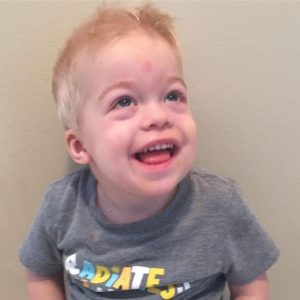November 16th, 2021 is Sanfilippo Awareness Day. This international day aims to spread awareness and spark conversations about Sanfilippo Syndrome.
Today we honor children worldwide living with Sanfilippo, those we have lost to this heartbreaking disease, and the families of these precious children.
Families like the Mackey’s. Bonnie and Shaun are among my closest childhood friends. They lost their son Connor at the age of 3 earlier this year following complications from Sanfilippo Syndrome.
Conner was joyful. His laugh was contagious. He loved playing ball, splashing in the swimming pool with his sister Aelish, and sliding at the park. He was happiest sitting sandwiched between his mom and dad, talking to his favorite person, Grandma, at family dinner.

Connor’s life was cut short, but the impression he left–his bright light–lives on. It is in his memory and in honor of his entire family that we are sharing about Sanfilippo today.
Who does Sanfilippo affect?
Sanfilippo is a rare genetic disease: 1 in 70,000 children are born with this inherited condition. While its occurrence is rare, its effects are deep. The child, their family, the school community, neighbors, and beyond are affected.
What is Sanfilippo Syndrome?
Sanfilippo (san-fuh-LEE-po) syndrome is a rare genetic metabolism disorder. A change in a single gene makes a child’s body unable to break down certain carbohydrates. This leads to serious problems in the brain and nervous system.
Kids who have the condition are born with it. But most won’t have symptoms until the preschool years. Then, they start to show trouble with sleep, developmental delays, and behavioral issues. Eventually having progressive loss of motor skills and severe cognitive problems. Sanfilippo syndrome affects life expectancy. Most children reach their teenage years, and some can live longer.
While there is no cure at this time, doctors and researchers are working hard to find better treatments.
What should caregivers look for?
Early signs of Sanfilippo syndrome can include:
- Speech and other developmental delays
- Repeated ear, sinus, or respiratory infections
- Large head size
- Ongoing diarrhea
- Compulsive behaviors and hyperactivity
- Seizures
When are children typically diagnosed?
Between the age of two and six.
Where can families find resources?
Learning that a child has Sanfilippo syndrome can be overwhelming and upsetting.
Turn to your child’s doctor for help and information. They’re there to support your child and the whole family. You also can find information, including connections to support groups, online at:
How Is Sanfilippo Syndrome Diagnosed?
Because it’s so rare, it can take time for a child to be diagnosed with Sanfilippo syndrome.
A urine test to check for high levels of GAGs can help confirm a diagnosis.
How Is Sanfilippo Syndrome Treated?
Treatment focuses on easing symptoms and giving a child the best quality of life for as long as possible.
Clinical trials, if you qualify, with enzyme replacement and gene therapy are high risk but offer doctors and families hope of slowing the progression of the disease and offering the best quality of life.
How can you help?
Being there for any friend experiencing this.









